Financial Reporting: SOCF, Accounting Standards and Ethical Issues
VerifiedAdded on 2020/06/04
|7
|1784
|77
Report
AI Summary
This report provides a comprehensive analysis of financial reporting, focusing on the Statement of Cash Flows (SOCF) and its significance to stakeholders. It examines how SOCF offers insights into an enterprise's cash inflows and outflows related to operating, investing, and financing activities, impacting decisions related to profitability, solvency, and liquidity. The report further explores the differences between 'rules-based' and 'principles-based' accounting standards, highlighting their application in financial statements. It critically analyses these two standards, emphasizing the ethical challenges accountants face when transitioning from rules-based to principles-based approaches, including pressures from management and potential conflicts related to financial statement manipulation. The report concludes by emphasizing the importance of financial reporting in providing stakeholders with crucial information and the ethical considerations that accountants must navigate in their work. The report references several books and journals, as well as online resources, to support its findings and analysis.
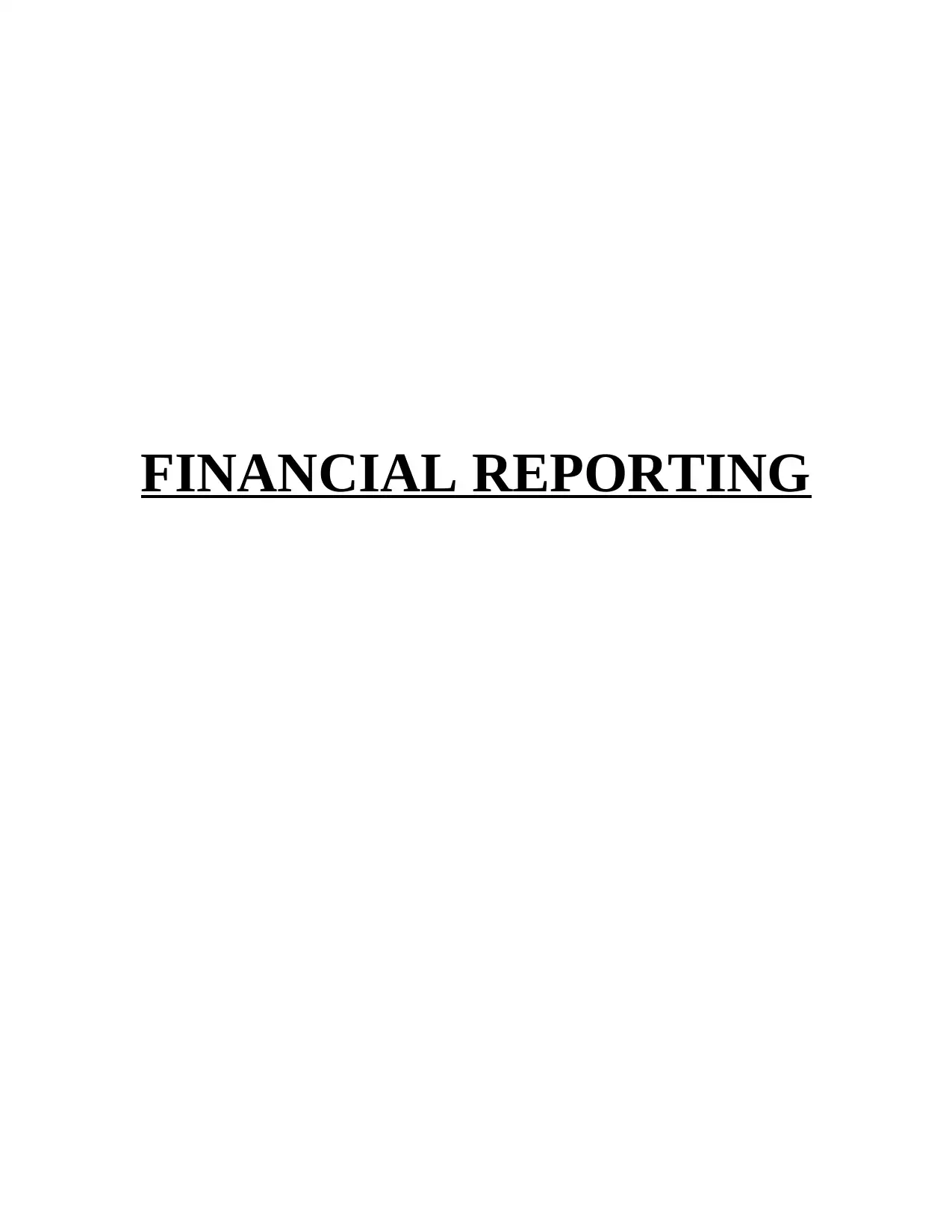
FINANCIAL REPORTING
Paraphrase This Document
Need a fresh take? Get an instant paraphrase of this document with our AI Paraphraser
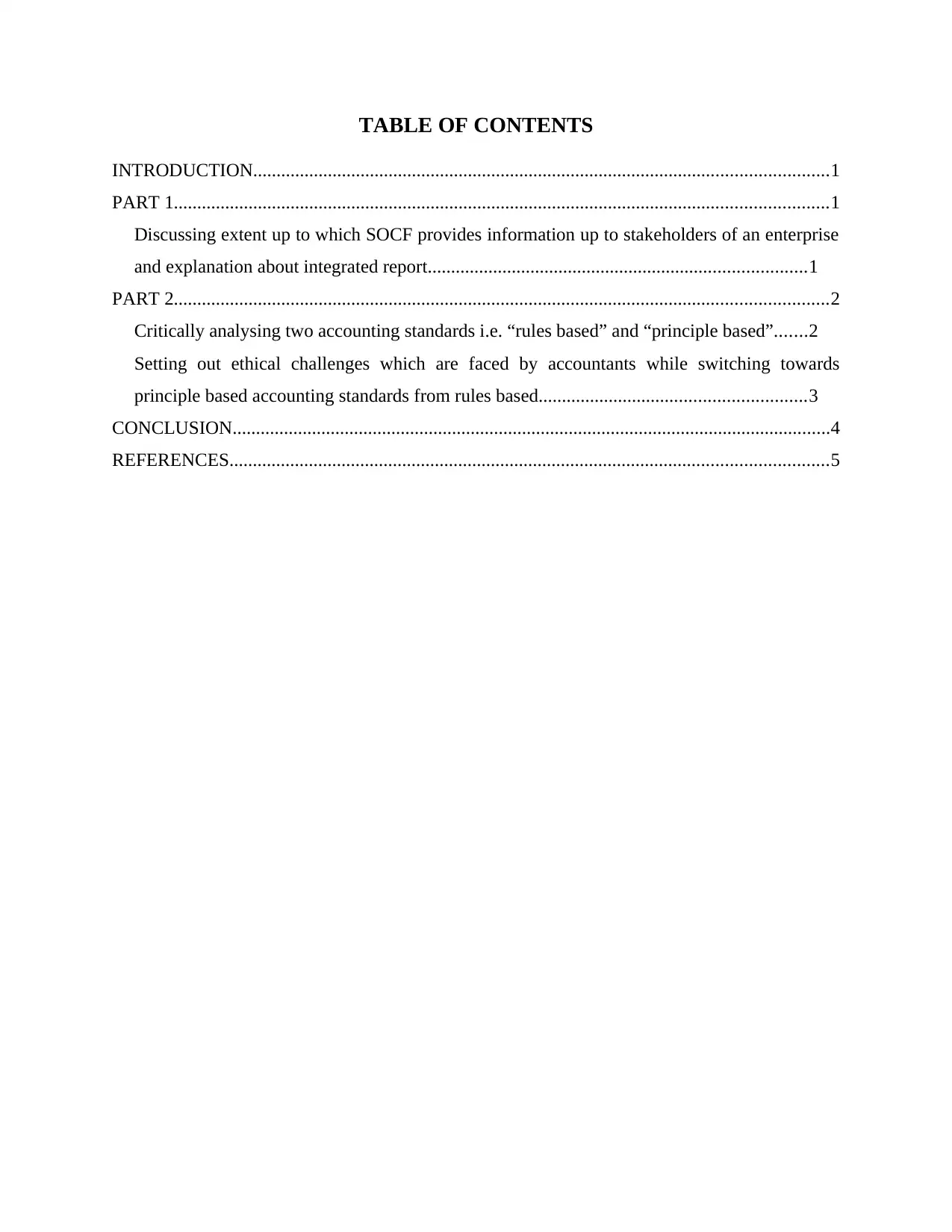
TABLE OF CONTENTS
INTRODUCTION...........................................................................................................................1
PART 1............................................................................................................................................1
Discussing extent up to which SOCF provides information up to stakeholders of an enterprise
and explanation about integrated report.................................................................................1
PART 2............................................................................................................................................2
Critically analysing two accounting standards i.e. “rules based” and “principle based”.......2
Setting out ethical challenges which are faced by accountants while switching towards
principle based accounting standards from rules based.........................................................3
CONCLUSION................................................................................................................................4
REFERENCES................................................................................................................................5
INTRODUCTION...........................................................................................................................1
PART 1............................................................................................................................................1
Discussing extent up to which SOCF provides information up to stakeholders of an enterprise
and explanation about integrated report.................................................................................1
PART 2............................................................................................................................................2
Critically analysing two accounting standards i.e. “rules based” and “principle based”.......2
Setting out ethical challenges which are faced by accountants while switching towards
principle based accounting standards from rules based.........................................................3
CONCLUSION................................................................................................................................4
REFERENCES................................................................................................................................5
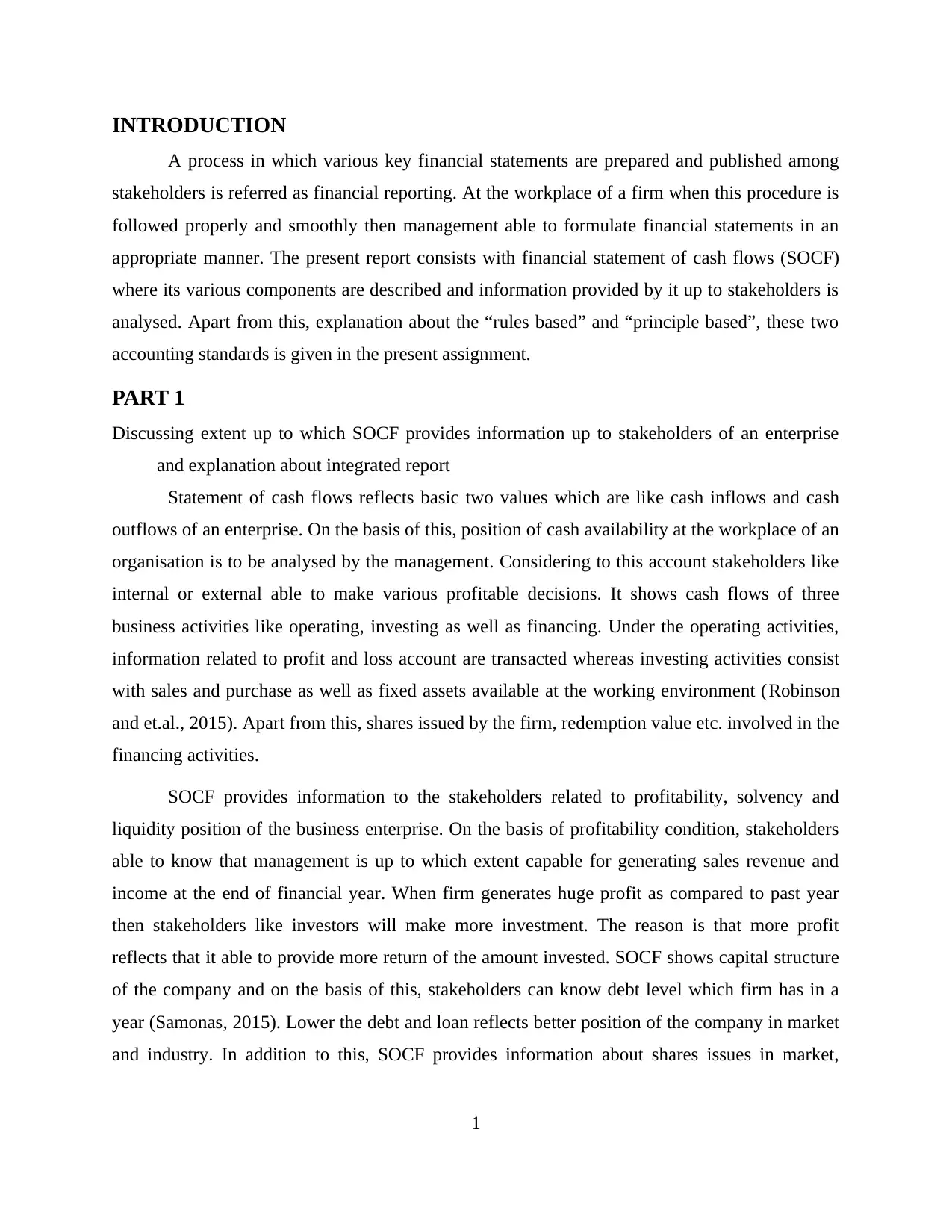
INTRODUCTION
A process in which various key financial statements are prepared and published among
stakeholders is referred as financial reporting. At the workplace of a firm when this procedure is
followed properly and smoothly then management able to formulate financial statements in an
appropriate manner. The present report consists with financial statement of cash flows (SOCF)
where its various components are described and information provided by it up to stakeholders is
analysed. Apart from this, explanation about the “rules based” and “principle based”, these two
accounting standards is given in the present assignment.
PART 1
Discussing extent up to which SOCF provides information up to stakeholders of an enterprise
and explanation about integrated report
Statement of cash flows reflects basic two values which are like cash inflows and cash
outflows of an enterprise. On the basis of this, position of cash availability at the workplace of an
organisation is to be analysed by the management. Considering to this account stakeholders like
internal or external able to make various profitable decisions. It shows cash flows of three
business activities like operating, investing as well as financing. Under the operating activities,
information related to profit and loss account are transacted whereas investing activities consist
with sales and purchase as well as fixed assets available at the working environment (Robinson
and et.al., 2015). Apart from this, shares issued by the firm, redemption value etc. involved in the
financing activities.
SOCF provides information to the stakeholders related to profitability, solvency and
liquidity position of the business enterprise. On the basis of profitability condition, stakeholders
able to know that management is up to which extent capable for generating sales revenue and
income at the end of financial year. When firm generates huge profit as compared to past year
then stakeholders like investors will make more investment. The reason is that more profit
reflects that it able to provide more return of the amount invested. SOCF shows capital structure
of the company and on the basis of this, stakeholders can know debt level which firm has in a
year (Samonas, 2015). Lower the debt and loan reflects better position of the company in market
and industry. In addition to this, SOCF provides information about shares issues in market,
1
A process in which various key financial statements are prepared and published among
stakeholders is referred as financial reporting. At the workplace of a firm when this procedure is
followed properly and smoothly then management able to formulate financial statements in an
appropriate manner. The present report consists with financial statement of cash flows (SOCF)
where its various components are described and information provided by it up to stakeholders is
analysed. Apart from this, explanation about the “rules based” and “principle based”, these two
accounting standards is given in the present assignment.
PART 1
Discussing extent up to which SOCF provides information up to stakeholders of an enterprise
and explanation about integrated report
Statement of cash flows reflects basic two values which are like cash inflows and cash
outflows of an enterprise. On the basis of this, position of cash availability at the workplace of an
organisation is to be analysed by the management. Considering to this account stakeholders like
internal or external able to make various profitable decisions. It shows cash flows of three
business activities like operating, investing as well as financing. Under the operating activities,
information related to profit and loss account are transacted whereas investing activities consist
with sales and purchase as well as fixed assets available at the working environment (Robinson
and et.al., 2015). Apart from this, shares issued by the firm, redemption value etc. involved in the
financing activities.
SOCF provides information to the stakeholders related to profitability, solvency and
liquidity position of the business enterprise. On the basis of profitability condition, stakeholders
able to know that management is up to which extent capable for generating sales revenue and
income at the end of financial year. When firm generates huge profit as compared to past year
then stakeholders like investors will make more investment. The reason is that more profit
reflects that it able to provide more return of the amount invested. SOCF shows capital structure
of the company and on the basis of this, stakeholders can know debt level which firm has in a
year (Samonas, 2015). Lower the debt and loan reflects better position of the company in market
and industry. In addition to this, SOCF provides information about shares issues in market,
1
⊘ This is a preview!⊘
Do you want full access?
Subscribe today to unlock all pages.

Trusted by 1+ million students worldwide
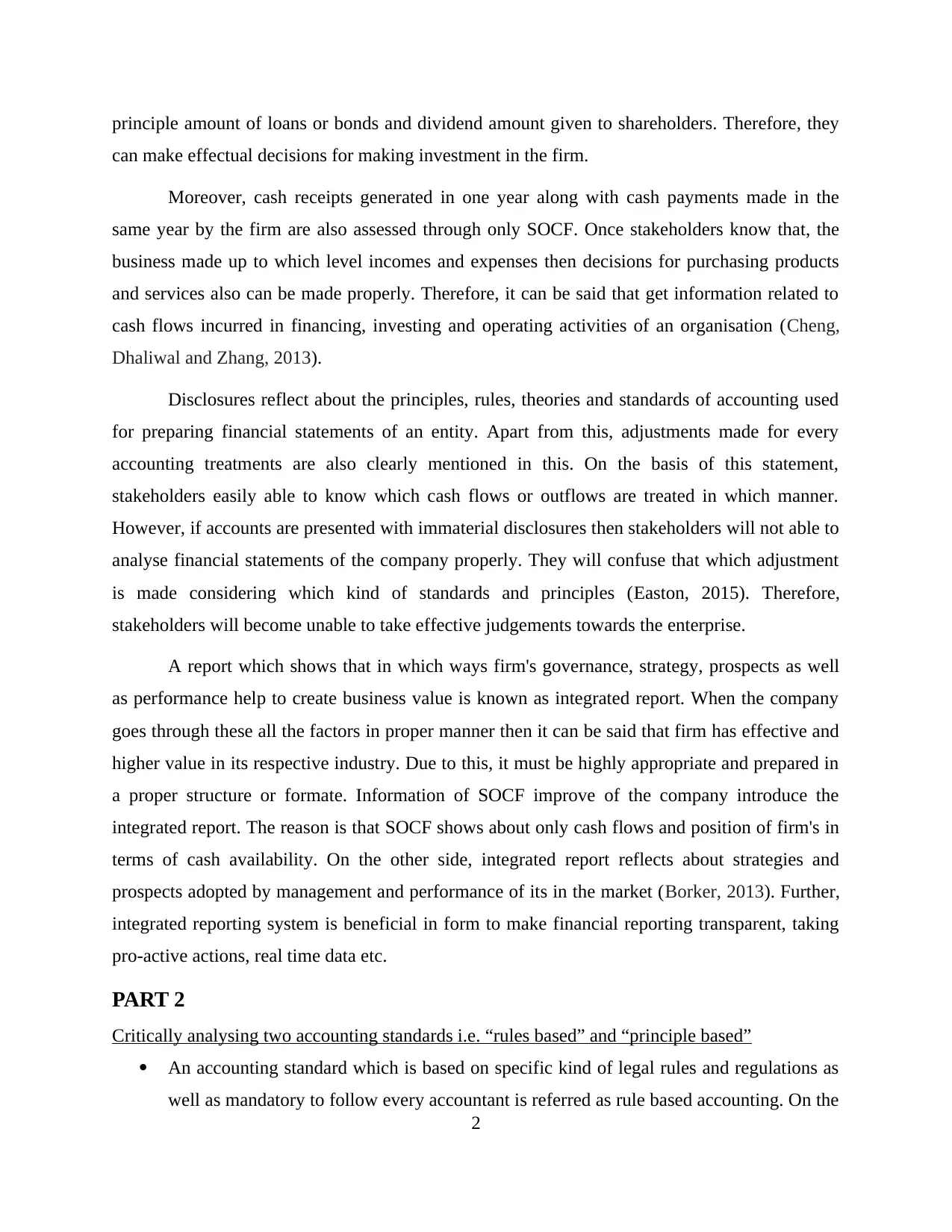
principle amount of loans or bonds and dividend amount given to shareholders. Therefore, they
can make effectual decisions for making investment in the firm.
Moreover, cash receipts generated in one year along with cash payments made in the
same year by the firm are also assessed through only SOCF. Once stakeholders know that, the
business made up to which level incomes and expenses then decisions for purchasing products
and services also can be made properly. Therefore, it can be said that get information related to
cash flows incurred in financing, investing and operating activities of an organisation (Cheng,
Dhaliwal and Zhang, 2013).
Disclosures reflect about the principles, rules, theories and standards of accounting used
for preparing financial statements of an entity. Apart from this, adjustments made for every
accounting treatments are also clearly mentioned in this. On the basis of this statement,
stakeholders easily able to know which cash flows or outflows are treated in which manner.
However, if accounts are presented with immaterial disclosures then stakeholders will not able to
analyse financial statements of the company properly. They will confuse that which adjustment
is made considering which kind of standards and principles (Easton, 2015). Therefore,
stakeholders will become unable to take effective judgements towards the enterprise.
A report which shows that in which ways firm's governance, strategy, prospects as well
as performance help to create business value is known as integrated report. When the company
goes through these all the factors in proper manner then it can be said that firm has effective and
higher value in its respective industry. Due to this, it must be highly appropriate and prepared in
a proper structure or formate. Information of SOCF improve of the company introduce the
integrated report. The reason is that SOCF shows about only cash flows and position of firm's in
terms of cash availability. On the other side, integrated report reflects about strategies and
prospects adopted by management and performance of its in the market (Borker, 2013). Further,
integrated reporting system is beneficial in form to make financial reporting transparent, taking
pro-active actions, real time data etc.
PART 2
Critically analysing two accounting standards i.e. “rules based” and “principle based”
An accounting standard which is based on specific kind of legal rules and regulations as
well as mandatory to follow every accountant is referred as rule based accounting. On the
2
can make effectual decisions for making investment in the firm.
Moreover, cash receipts generated in one year along with cash payments made in the
same year by the firm are also assessed through only SOCF. Once stakeholders know that, the
business made up to which level incomes and expenses then decisions for purchasing products
and services also can be made properly. Therefore, it can be said that get information related to
cash flows incurred in financing, investing and operating activities of an organisation (Cheng,
Dhaliwal and Zhang, 2013).
Disclosures reflect about the principles, rules, theories and standards of accounting used
for preparing financial statements of an entity. Apart from this, adjustments made for every
accounting treatments are also clearly mentioned in this. On the basis of this statement,
stakeholders easily able to know which cash flows or outflows are treated in which manner.
However, if accounts are presented with immaterial disclosures then stakeholders will not able to
analyse financial statements of the company properly. They will confuse that which adjustment
is made considering which kind of standards and principles (Easton, 2015). Therefore,
stakeholders will become unable to take effective judgements towards the enterprise.
A report which shows that in which ways firm's governance, strategy, prospects as well
as performance help to create business value is known as integrated report. When the company
goes through these all the factors in proper manner then it can be said that firm has effective and
higher value in its respective industry. Due to this, it must be highly appropriate and prepared in
a proper structure or formate. Information of SOCF improve of the company introduce the
integrated report. The reason is that SOCF shows about only cash flows and position of firm's in
terms of cash availability. On the other side, integrated report reflects about strategies and
prospects adopted by management and performance of its in the market (Borker, 2013). Further,
integrated reporting system is beneficial in form to make financial reporting transparent, taking
pro-active actions, real time data etc.
PART 2
Critically analysing two accounting standards i.e. “rules based” and “principle based”
An accounting standard which is based on specific kind of legal rules and regulations as
well as mandatory to follow every accountant is referred as rule based accounting. On the
2
Paraphrase This Document
Need a fresh take? Get an instant paraphrase of this document with our AI Paraphraser
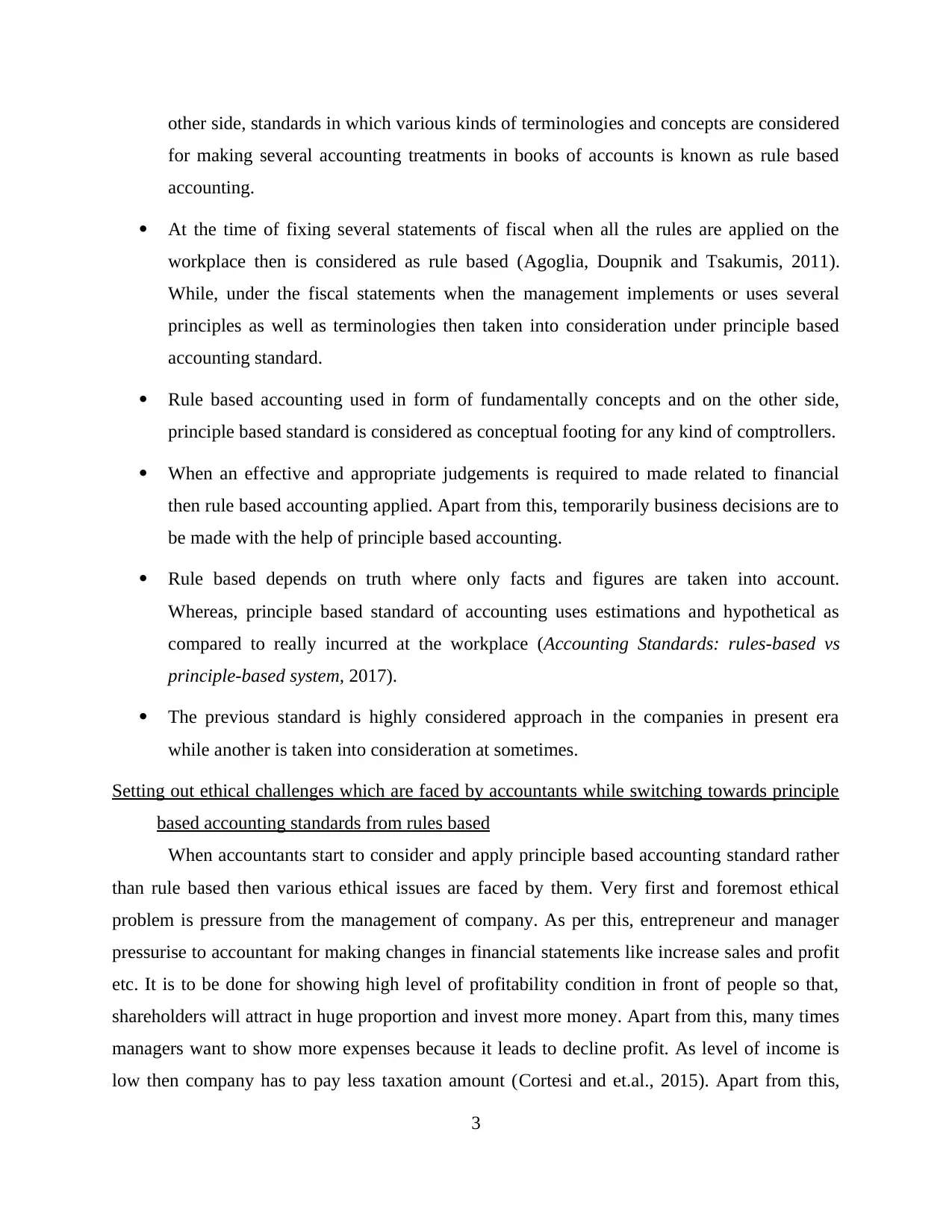
other side, standards in which various kinds of terminologies and concepts are considered
for making several accounting treatments in books of accounts is known as rule based
accounting.
At the time of fixing several statements of fiscal when all the rules are applied on the
workplace then is considered as rule based (Agoglia, Doupnik and Tsakumis, 2011).
While, under the fiscal statements when the management implements or uses several
principles as well as terminologies then taken into consideration under principle based
accounting standard.
Rule based accounting used in form of fundamentally concepts and on the other side,
principle based standard is considered as conceptual footing for any kind of comptrollers.
When an effective and appropriate judgements is required to made related to financial
then rule based accounting applied. Apart from this, temporarily business decisions are to
be made with the help of principle based accounting.
Rule based depends on truth where only facts and figures are taken into account.
Whereas, principle based standard of accounting uses estimations and hypothetical as
compared to really incurred at the workplace (Accounting Standards: rules-based vs
principle-based system, 2017).
The previous standard is highly considered approach in the companies in present era
while another is taken into consideration at sometimes.
Setting out ethical challenges which are faced by accountants while switching towards principle
based accounting standards from rules based
When accountants start to consider and apply principle based accounting standard rather
than rule based then various ethical issues are faced by them. Very first and foremost ethical
problem is pressure from the management of company. As per this, entrepreneur and manager
pressurise to accountant for making changes in financial statements like increase sales and profit
etc. It is to be done for showing high level of profitability condition in front of people so that,
shareholders will attract in huge proportion and invest more money. Apart from this, many times
managers want to show more expenses because it leads to decline profit. As level of income is
low then company has to pay less taxation amount (Cortesi and et.al., 2015). Apart from this,
3
for making several accounting treatments in books of accounts is known as rule based
accounting.
At the time of fixing several statements of fiscal when all the rules are applied on the
workplace then is considered as rule based (Agoglia, Doupnik and Tsakumis, 2011).
While, under the fiscal statements when the management implements or uses several
principles as well as terminologies then taken into consideration under principle based
accounting standard.
Rule based accounting used in form of fundamentally concepts and on the other side,
principle based standard is considered as conceptual footing for any kind of comptrollers.
When an effective and appropriate judgements is required to made related to financial
then rule based accounting applied. Apart from this, temporarily business decisions are to
be made with the help of principle based accounting.
Rule based depends on truth where only facts and figures are taken into account.
Whereas, principle based standard of accounting uses estimations and hypothetical as
compared to really incurred at the workplace (Accounting Standards: rules-based vs
principle-based system, 2017).
The previous standard is highly considered approach in the companies in present era
while another is taken into consideration at sometimes.
Setting out ethical challenges which are faced by accountants while switching towards principle
based accounting standards from rules based
When accountants start to consider and apply principle based accounting standard rather
than rule based then various ethical issues are faced by them. Very first and foremost ethical
problem is pressure from the management of company. As per this, entrepreneur and manager
pressurise to accountant for making changes in financial statements like increase sales and profit
etc. It is to be done for showing high level of profitability condition in front of people so that,
shareholders will attract in huge proportion and invest more money. Apart from this, many times
managers want to show more expenses because it leads to decline profit. As level of income is
low then company has to pay less taxation amount (Cortesi and et.al., 2015). Apart from this,
3
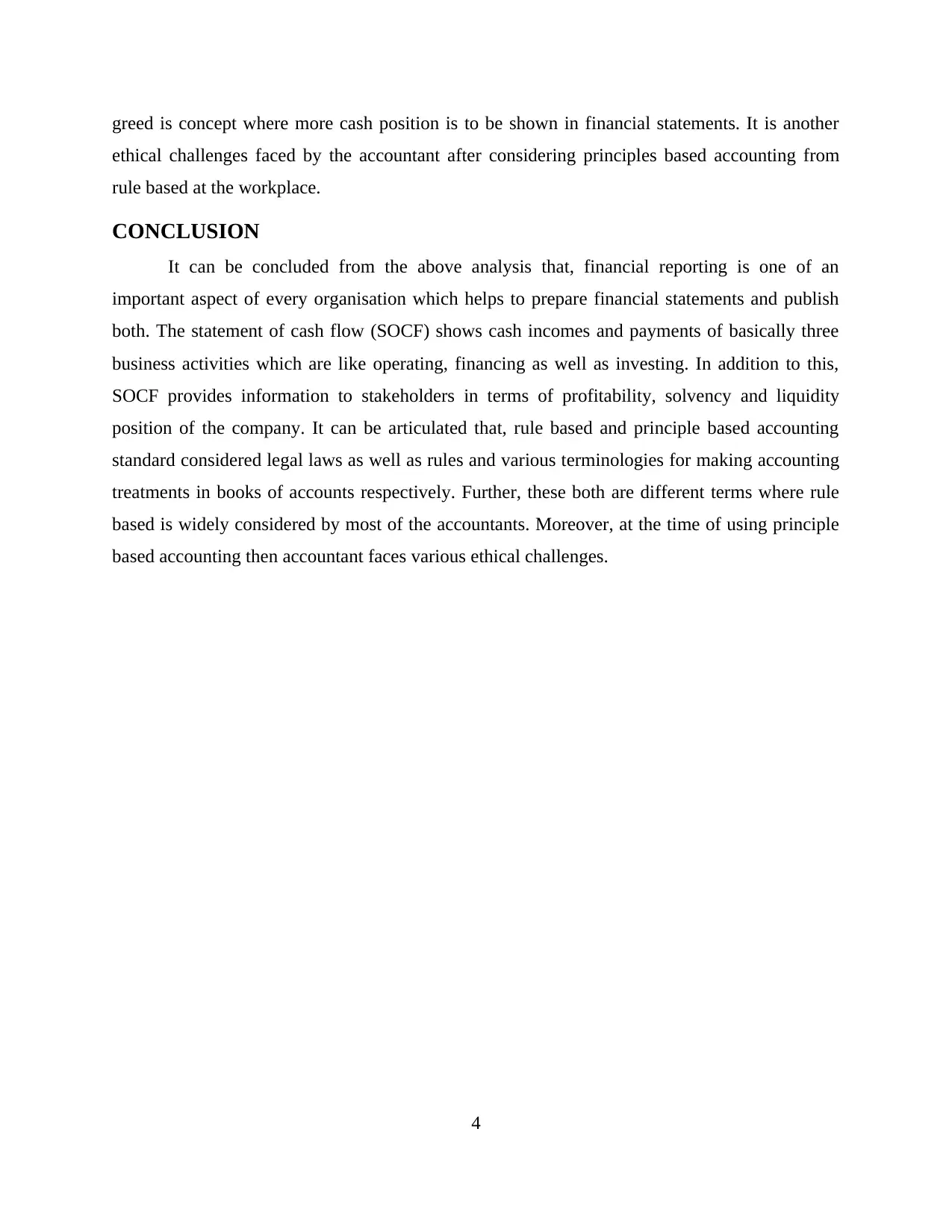
greed is concept where more cash position is to be shown in financial statements. It is another
ethical challenges faced by the accountant after considering principles based accounting from
rule based at the workplace.
CONCLUSION
It can be concluded from the above analysis that, financial reporting is one of an
important aspect of every organisation which helps to prepare financial statements and publish
both. The statement of cash flow (SOCF) shows cash incomes and payments of basically three
business activities which are like operating, financing as well as investing. In addition to this,
SOCF provides information to stakeholders in terms of profitability, solvency and liquidity
position of the company. It can be articulated that, rule based and principle based accounting
standard considered legal laws as well as rules and various terminologies for making accounting
treatments in books of accounts respectively. Further, these both are different terms where rule
based is widely considered by most of the accountants. Moreover, at the time of using principle
based accounting then accountant faces various ethical challenges.
4
ethical challenges faced by the accountant after considering principles based accounting from
rule based at the workplace.
CONCLUSION
It can be concluded from the above analysis that, financial reporting is one of an
important aspect of every organisation which helps to prepare financial statements and publish
both. The statement of cash flow (SOCF) shows cash incomes and payments of basically three
business activities which are like operating, financing as well as investing. In addition to this,
SOCF provides information to stakeholders in terms of profitability, solvency and liquidity
position of the company. It can be articulated that, rule based and principle based accounting
standard considered legal laws as well as rules and various terminologies for making accounting
treatments in books of accounts respectively. Further, these both are different terms where rule
based is widely considered by most of the accountants. Moreover, at the time of using principle
based accounting then accountant faces various ethical challenges.
4
⊘ This is a preview!⊘
Do you want full access?
Subscribe today to unlock all pages.

Trusted by 1+ million students worldwide
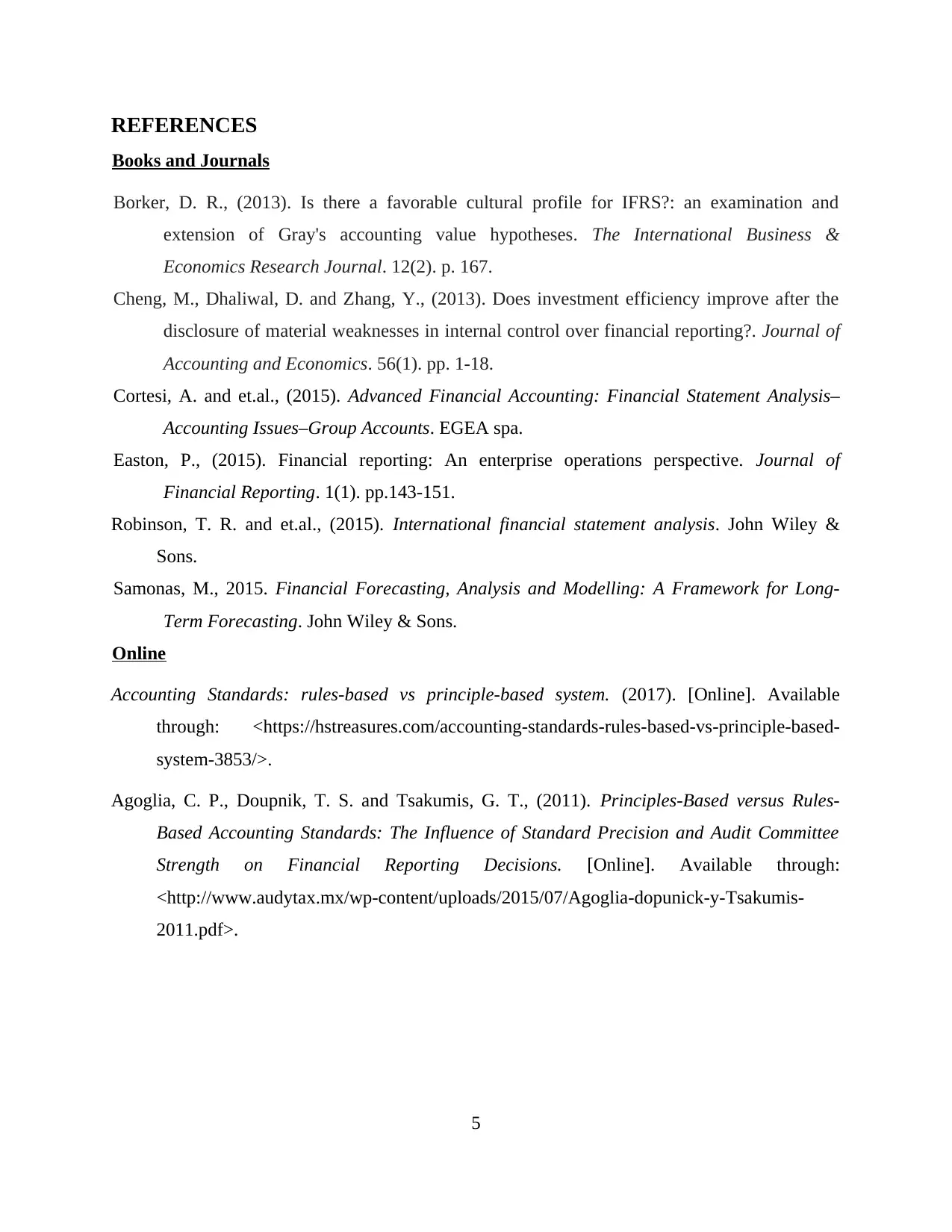
REFERENCES
Books and Journals
Borker, D. R., (2013). Is there a favorable cultural profile for IFRS?: an examination and
extension of Gray's accounting value hypotheses. The International Business &
Economics Research Journal. 12(2). p. 167.
Cheng, M., Dhaliwal, D. and Zhang, Y., (2013). Does investment efficiency improve after the
disclosure of material weaknesses in internal control over financial reporting?. Journal of
Accounting and Economics. 56(1). pp. 1-18.
Cortesi, A. and et.al., (2015). Advanced Financial Accounting: Financial Statement Analysis–
Accounting Issues–Group Accounts. EGEA spa.
Easton, P., (2015). Financial reporting: An enterprise operations perspective. Journal of
Financial Reporting. 1(1). pp.143-151.
Robinson, T. R. and et.al., (2015). International financial statement analysis. John Wiley &
Sons.
Samonas, M., 2015. Financial Forecasting, Analysis and Modelling: A Framework for Long-
Term Forecasting. John Wiley & Sons.
Online
Accounting Standards: rules-based vs principle-based system. (2017). [Online]. Available
through: <https://hstreasures.com/accounting-standards-rules-based-vs-principle-based-
system-3853/>.
Agoglia, C. P., Doupnik, T. S. and Tsakumis, G. T., (2011). Principles-Based versus Rules-
Based Accounting Standards: The Influence of Standard Precision and Audit Committee
Strength on Financial Reporting Decisions. [Online]. Available through:
<http://www.audytax.mx/wp-content/uploads/2015/07/Agoglia-dopunick-y-Tsakumis-
2011.pdf>.
5
Books and Journals
Borker, D. R., (2013). Is there a favorable cultural profile for IFRS?: an examination and
extension of Gray's accounting value hypotheses. The International Business &
Economics Research Journal. 12(2). p. 167.
Cheng, M., Dhaliwal, D. and Zhang, Y., (2013). Does investment efficiency improve after the
disclosure of material weaknesses in internal control over financial reporting?. Journal of
Accounting and Economics. 56(1). pp. 1-18.
Cortesi, A. and et.al., (2015). Advanced Financial Accounting: Financial Statement Analysis–
Accounting Issues–Group Accounts. EGEA spa.
Easton, P., (2015). Financial reporting: An enterprise operations perspective. Journal of
Financial Reporting. 1(1). pp.143-151.
Robinson, T. R. and et.al., (2015). International financial statement analysis. John Wiley &
Sons.
Samonas, M., 2015. Financial Forecasting, Analysis and Modelling: A Framework for Long-
Term Forecasting. John Wiley & Sons.
Online
Accounting Standards: rules-based vs principle-based system. (2017). [Online]. Available
through: <https://hstreasures.com/accounting-standards-rules-based-vs-principle-based-
system-3853/>.
Agoglia, C. P., Doupnik, T. S. and Tsakumis, G. T., (2011). Principles-Based versus Rules-
Based Accounting Standards: The Influence of Standard Precision and Audit Committee
Strength on Financial Reporting Decisions. [Online]. Available through:
<http://www.audytax.mx/wp-content/uploads/2015/07/Agoglia-dopunick-y-Tsakumis-
2011.pdf>.
5
1 out of 7
Related Documents
Your All-in-One AI-Powered Toolkit for Academic Success.
+13062052269
info@desklib.com
Available 24*7 on WhatsApp / Email
![[object Object]](/_next/static/media/star-bottom.7253800d.svg)
Unlock your academic potential
Copyright © 2020–2025 A2Z Services. All Rights Reserved. Developed and managed by ZUCOL.




